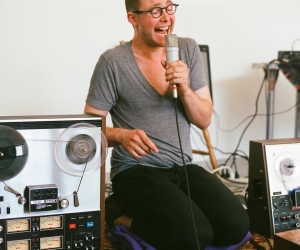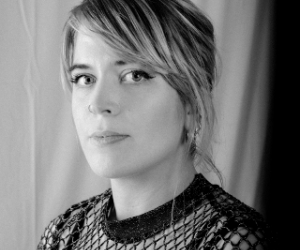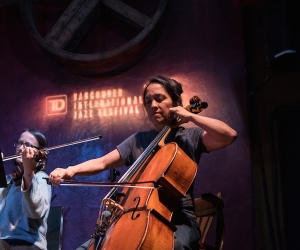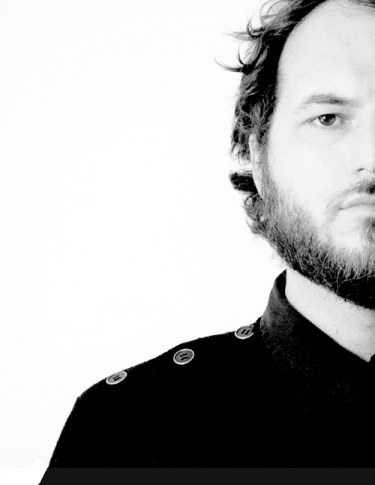
“I know it may sound crazy, but I am interested in making beautiful music—music that sounds good. I’m not saying this just to be different, and it might not be in line with a lot of the reasons that people make music today, but I am actually not very involved with, or worrying so much about, a process—about how I write the music, or any kind of system. I just want the work to be inherently musical and for musicality to be the main concern.”
In the fields of modern composition and free improvisation, it is surprising to hear a musician privilege beauty over process and technique, but it certainly makes sense coming from percussionist and composer—and early-music singer!—Isaiah Ceccarelli, whose beautiful work is born out of a rich, seemingly contradictory set of experiences and influences. He straddles many lines—such as the ones between rigorous training and autodidactism, and those between improvisational open-endedness and clearly articulated structures. He is thoroughly invested in both ancient and modern musical practices. Because of all this, his voice is radically individual and yet firmly anchored in various traditions.
Over the past decade, Ceccarelli has built a reputation as one of Montreal’s most gifted and innovative improvisers—equally comfortable exploring extensions of jazz on a kit and probing the various overtones of a single cymbal. Eclecticism may be increasingly common among younger musicians, yet Ceccarelli’s wide spectrum is cohesive and driven by precise intention, where others might veer into pastiche or aesthetic anonymity. Even when he’s assertively delineating pulse or conjuring a loud burst of convoluted resonances, you’ll find an underlying lyricism and an acute sense of harmony.
Recently, there has been growing interest in Ceccarelli as a composer—and rightly so. He’s discovered his own particular intersection, managing to relay in his compositions the tactile sensitivity of his own playing and to employ musical material economically, all the while producing deceptively bold colours and phrasing. His music offers many entry points—transparent, ostensibly simple textures, loose-knit moirés of microtones, attractive melodic contours, extended peals of pure timbre, even idiom-based gestures, plus frequent use of voice. This permeability in his composed works has attracted a wide variety of opportunities, ranging from large ensembles made up of improvisers to intimate chamber works played by leading contemporary music interpreters.
Born in Chetwynd, B.C., Ceccarelli grew up in San Bernardino, Calif., where his interest in playing music was ignited quite early by hearing a friend’s dad, who played drums in a gospel band. Private study began at age twelve, when he took up lessons with a local orchestral percussionist—a connection that endured until he went off to college in Boston, and one that remains evident today in the dynamic shapes of his playing. His instructor’s pedagogical foundation consisted of snare drum excerpts, timpani, and other orchestral percussion. Ceccarelli excelled, and he joined a larger regional youth symphony as principal timpanist. As his complementary interests in drum kit and jazz music grew, however, the young drummer began studying under jazz stalwart Ed Shaughnessy, known for his tenure on the The Tonight Show Starring Johnny Carson and as a sideman to Charles Mingus, Horace Silver, and Teo Macero. Shaughnessy’s jazz pedigree and no-nonsense angle resonated with the young drummer.
“I’ve never been good with following directions. I don’t take orders well, either,” Ceccarelli chuckles. “I’m a very independent person. But there was something in the tradition of it all that stuck with me—learning from a real jazz drummer who was around back in the day. I did all the stuff that is absolutely indispensable to me now.” Under Shaughnessy’s tutelage he was fed a constant stream of exercises and big-band music to be sight-read—all intended to give him every resource necessary to become a full-time musician. The elder drummer’s refrain to the young musician was that he should absorb completely the fundamentals of playing before doing anything else. “I'm a little bit conservative in this sense,” Ceccarelli notes, with wry acknowledgement of the irony of that statement. “I teach my students this as well. I really believe in that kind of working musician’s approach. Everything I ever studied was about making a living. You learn to do the basics well, and you can do anything you want. Your creativity comes after you can really play your instrument.” While that is by no means a revolutionary concept in music training, both Shaughnessy and Ceccarelli understood it as pragmatism, not dogmatism—more a case of being versatile, competent, and expressive in order to cover all your bases, rather than merely blindly following rules. “Even now, as I get closer to the music I want to do, it’s kind of a no-nonsense approach too.” His mentor’s role was not just relegated to teaching traditional grip and the various shadings of brush-playing—he also imparted a wealth of insight into the gigging musician’s lifestyle, including the importance of business savvy and humour.
After his four years under Shaughnessy, Ceccarelli did not feel the least bit inclined to audition for orchestral posts and, instead, set his sights on Berklee College of Music in Boston, where his interest in more improvisatory and exploratory forms began to take shape, spurred on by peers who had a more introverted, European-jazz sensibility in their playing. He recalls John Hazilla, one of his Berklee teachers, offering another liberating piece of wisdom: “You can work all you want to sound like somebody and you can never sound like them—you’ll always sound like yourself.” After his short time at Berklee, Ceccarelli spent a year gigging steadily and practising before becoming the first North American student at the Paris Conservatoire’s jazz performance program. But he was unable to spend much time there, as he was neither able to work in France nor able to forestall the debt he accrued at Berklee. “I’m a dropout from two places,” he jokes.
His journey led him to Montreal in 2003. Accustomed to the competitive energy of the two aforementioned music institutions, Ceccarelli was initially taken aback by the city’s warmth and nonchalance. After catching avant-garde saxophonist and flautist Jean Derome and percussionist Pierre Tanguay playing on TV, he sought out a lesson from the latter, who politely declined and, instead, extended an invitation to play together at his studio. “I was getting ready to pay this guy $100 for a lesson, but that kind of student or post-student attitude doesn’t fly in Montreal. I showed up in Montreal with business cards and shit. I was not prepared,” he says, with a laugh at his own naivety. After forty-five minutes of playing with Tanguay, they went for an hour-long walk in November (to get used to the cold, of course) and then ate lunch. Ceccarelli credits Tanguay with helping make initial contact within the scene, introducing him to fellow improvisers and even calling him in as a sub for shows. Ceccarelli soon began organizing concerts at the now-defunct Zeke’s Gallery, where he became acquainted with players such as Joane Hétu, Lori Freedman, and Derome. He also used the venue to showcase his own ensembles.
One such ensemble is documented on Lieux-dits (2006, Ambiances Magnétiques), which is his first album under his own name, and marks his first serious foray into composing. The music—composed for Frank Lozano and Derome (both of them on sax and other winds), Clinton Ryder (bass), and Steve Raegele (guitar)—is ostensibly jazz-based, but is meticulously written out, drawing on rhythmic and harmonic concepts from none other than Messiaen, as Ceccarelli points out.
On Bréviaire d'epuisments (2010) he formulates a more cohesive image. Never having been formally trained as a composer, Ceccarelli exhibits in these works a reverent disregard for both the purity of the diverse musical elements at play, and the conventions around the idea of fusion. Refreshingly devoid of conspicuous citations and other such trappings, the thirteen pieces seamlessly and respectfully integrate various aspects of his interest and practice. He interesperses solo pieces and ensemble settings of the poetry of Marie Deschênes, and the spare intertwining vocal melodies and the spacious, hovering instrumental sonorities mark a distinct shift from his previous work. Also notable is the absence of anything resembling jazz drumming. The melodic inflections are indicative of his strong connection (as a singer himself) to the Renaissance vocal repertoire, yet the music’s gentle equanimity and harmonic language is undeniably a product of today. Performed by Pierre-Yves Martel on viola da gamba, both Lori Freedman and Philippe Lauzier on bass clarinets, and singers Emilie Laforest and Josée Lalonde, the majority of the ensemble pieces are decidedly slender and melodic, while the solo pieces are intensely focused on metallic percussion drones whose symphonic complexity betrays their singular sound source.
Ceccarelli’s participation in 2012 in the Quatuor Bozzini’s annual Composers Kitchen—a veritable hotbed of emerging voices in new composition—was his crucial initiation into the new music community. It also was one of his first opportunities to identify himself as a composer, without necessarily being associated only with the improv scene. That year, the workshop was a copresentation in England with the celebrated Huddersfield Contemporary Music Festival, and his work Magnuns was played on both sides of the Atlantic by the quartet. He has since performed with the quartet as a percussionist—when they showcased the work of the Wandelweiser collective in 2013—and he has also received an ambitious commission for the quartet’s next concert season, which engages musique actuelle supergroup Ensemble SuperMusique in a formation that adds a pair of saxophones and a pair of percussionists to the quartet.
During the time of Bréviaire and the Composers Kitchen, Ceccarelli found himself shifting away from improvisational settings, gravitating instead toward writing and improvising within more deliberate confines—be they through formal structures or in group settings where mutual trust and parallel intentions maximize ensemble potential. “I don’t feel constrained when I play music with a form,” he concedes, noting the great emphasis put on the concept “freedom” within improvisational circles. “My desire to compose has to do with—and I’m not afraid to say this—my desire to control more of the elements that are being played in the music.”
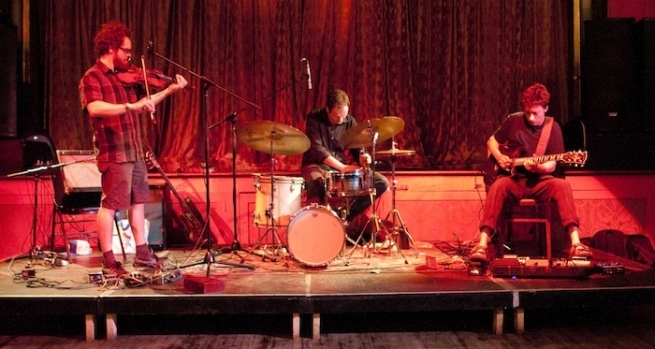
Although his activity as an improviser has become more focused, his practice remains inclusive to numerous improvisation-driven bands, all of which have a very pronounced and distinctive aesthetic sensibility. His trio Subtle Lip Can is primary among these, and tours extensively, ceaselessly cultivating its sound—which is extraordinarily difficult to pin down, yet instantly recognizable. Often exuding a peculiar gruffness, the trio’s brazen exterior belies both mystery and patience, with sound seldom heard outside of more reductionist contexts. Bypassing the more familiar conversational mode of improvisational interplay, textures wriggle, bristle, and undulate over and between each other—yet there’s always a certain poise to the spontaneous alignment of the sounds. No matter how entangled, coarse, or kinetic it gets, clarity prevails, affording ample breathing room to each gesture. Ceccarelli is at his most abstract in this setting, variously reimagining the drum kit as a chorus of deep, forlorn yawns, fleets of corroded trumpets, some sort of industrial menagerie, and many things that are even less tangible. Without any visual cues, it’s often difficult to ascertain who’s producing which sound. Violinist Joshua Zubot unleashes untamed creaks, strident ululations, and sharp scurries across the fingerboard, while Bernard Falaise cajoles his guitar into divulging all manner of secret unearthly utterances. Miraculously, amidst the deceptively tidy cacophony there’s still some well-concealed (either intentionally or not) tie to melody. For the listener, it’s like excavating a hidden tune, only to find yourself enraptured by everything else that makes its way to your ears.
Ceccarelli is also a member of Pierre-Yves Martel’s Quartetski, a band devoted to wayward interpretations, both improvisatory and celebratory, of classics, notably The Rite of Spring, Pictures at an Exhibition, Cage's String Quartet in Four Parts, and works by Duke Ellington, Erik Satie, and Tobias Hume. Though playful and a touch irreverent, the group wisely resists lampooning their source material; their process is more about extemporizing upon the untrodden paths within these masterworks, while maintaining the fundamental character of the respective works.
There’s also the Linden Project, Ceccarelli’s duo with Kaitlyn Clark (of the early and new-music chamber ensemble Les Amusement de la Chambre), which again evinces, albeit indirectly, his interest in vocal music. Instead of furnishing pulse to Clark’s soft organetto playing, he draws out long phonated resonances that shadow the delicate wafts of tone. Tilting, a band led by Nicolas Caloia (of Ratchet Orchestra infamy), engages Ceccarelli in a more straightforward jazz capacity, while still affording plenty of improvisation and interpretational leeway.
Ceccarelli’s interest in early vocal music has also flourished in the last few years. “I’m known in these three different circles. There’s a whole section of people who think that I [just] sing in this Gregorian Chant choir and that I’m some sort of mediaeval scholar—they have no idea of anything else that goes on. In these other scenes, nobody knows I've sung Sunday masses once a month for months and months."
His ambitious 2013 work Toute clarté m'est obscure is a deeply personal statement, particularly in the way that it reconciles his tripartite artistic existence. Enlisting what amounts to a chamber orchestra of sixteen improvising musicians, as well as a soprano singer, it was presented in SuperMusique’s season that year, within the suitably ecclesiastical grandeur of Montreal’s Church of St. John the Evangelist. The meditative ninety-minute work unfolds through soft majestic billows of pure tone and microsonic textural motion, swelling and receding to varying degrees of opacity. From these harmonic clouds, various motives surface, including foregrounded vocal melodies, as well as significant amounts of spontaneous input and interaction from the performers. The sung texts are Ceccarelli’s own, drawing on his deep connection to various facets of early-music traditions. Even apart from uniting his interests in modern composition, improv, and early musics, the work is emblematic of Ceccarelli’s sensibility on numerous levels. “This is a very personal journey, but listening to different kinds of recent music, I often find myself listening to it and feeling like I have to appreciate something else in order to appreciate the musical experience. I think part of what I’m interested in now as a composer, musically, is trying to simplify that, so that it becomes less important how it’s made. My great passion, so to speak, is Renaissance harmony and baroque music, like Monteverdi and Couperin. I’ve kind of discovered this music in the last ten years, in the same way that I discovered jazz and other things, where I’ve really felt this is ‘my music’—and of course, those are musics from the past, but I live now, and we are condemned to make music in the present.”
While his affinity for ancient musics reflects his desire to bypass the staunch conceptualism of many recent musical forms, it goes deeper than simple aesthetic questions, moving into the difficult realm of music’s connection to the spiritual—a topic that he approaches, like many musicians, with a degree of hesitation. He’s not one to actively allow his biographical information to be conflated with his musical expression, so specific questions pertaining to faith are not of concern to him. It’s a more general sentiment about what he says as music's most comfortable place.
“The role that music has played throughout history, up until a very recent point in time, was as sustenance for some kind of ritual, religious, or mystical experience. Within the last hundred years or so it’s been kind of out on its own—which is fine of course: things change—but music didn’t last that long just being based on how it’s been made. We’re already out of that; we’re back to ‘How does it sound?’ That’s what I’m interested in. Music, though, had a long run in service of something else, and I am not necessarily at ease with that and where to go with it.”
As Ceccarelli grapples with balancing tricky relationships between seemingly polar aspects—calculation and spontaneity, tradition and innovation, the befuddling and the alluring, and even the mundane and mysterious—we as audience members are witnesses to music-making which transparently displays its humanity, and somehow implicates the listener in these very questions of balance.
Isaiah Ceccarelli will participate as composer and performer in the Nu:Nord Conference in Oslo, Norway, in August 2014. The event includes the premiere performance of a piece for violin and percussion, which he is composing for his new duo with violinist Mira Benjamin, called Violin & Drums. He is also preparing to launch Reflective Drime, the second album from Subtle Lip Can. Readers can listen to some of the works mentioned in this article on Ceccarelli’s SoundCloud page.
Audio: Solo IV (composed and performed by Isaiah Ceccarelli). Homepage image of Isaiah Ceccarelli by: Nick Hyatt. Top image of Isaiah Ceccarelli by: Céline Côté. Image of Subtle Lip Can by: Chrissy Cheung.
